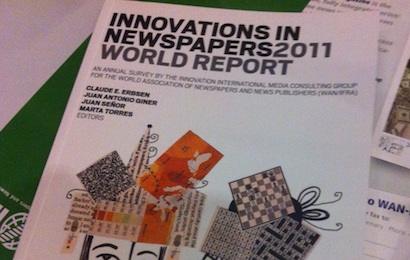In presenting the annual Innovations in Newspapers 2011 World Report, director of the Innovation Media Consulting Group Carlo Campos asked a question many delegates were likely to be interested to hear the answer to:
Are we witnessing the beginning of the end of the newspaper crisis?
And his answer:
We are starting to see hopeful signs we’re starting to pull through.
Specifically, he said, social media has begun to pay off, circulation is rising in developing countries, advertising is stabling, people are beginning to pay online and there are high profits in “decent economies”.
We have used the crisis to clean up our houses. Cut down a lot of the fat. We’re running operations that are as lean and mean as ever.
We’re abandoning volume for value. We want to have better audiences. We want to be more enaged and interact with them. Finally, we are reclaiming our content and putting a price on it.
Free is very expensive and ultimately unsustainable. Open does not need to mean free.
It is not about whether we should pay anymore, he said, it is about what people will pay for.
If you go into a bar and ask for tap water, it’s free. If you ask for champagne you have to pay for it. Peanuts are free in the bar, but if you ask for caviar you have to pay.
The problem is 80 per cent of the content we produce is peanuts. Only 20 per cent is caviar but nevertheless we want people to pay for everything. We need to produce caviar news so people will pay. You can still give peanuts to get people to come in and sit with you.
You can get the full report at this link, which offers a number of examples of innovations within news from across the world.
Journalism.co.uk is bringing you reports from the World Editors Forum throughout the conference.
